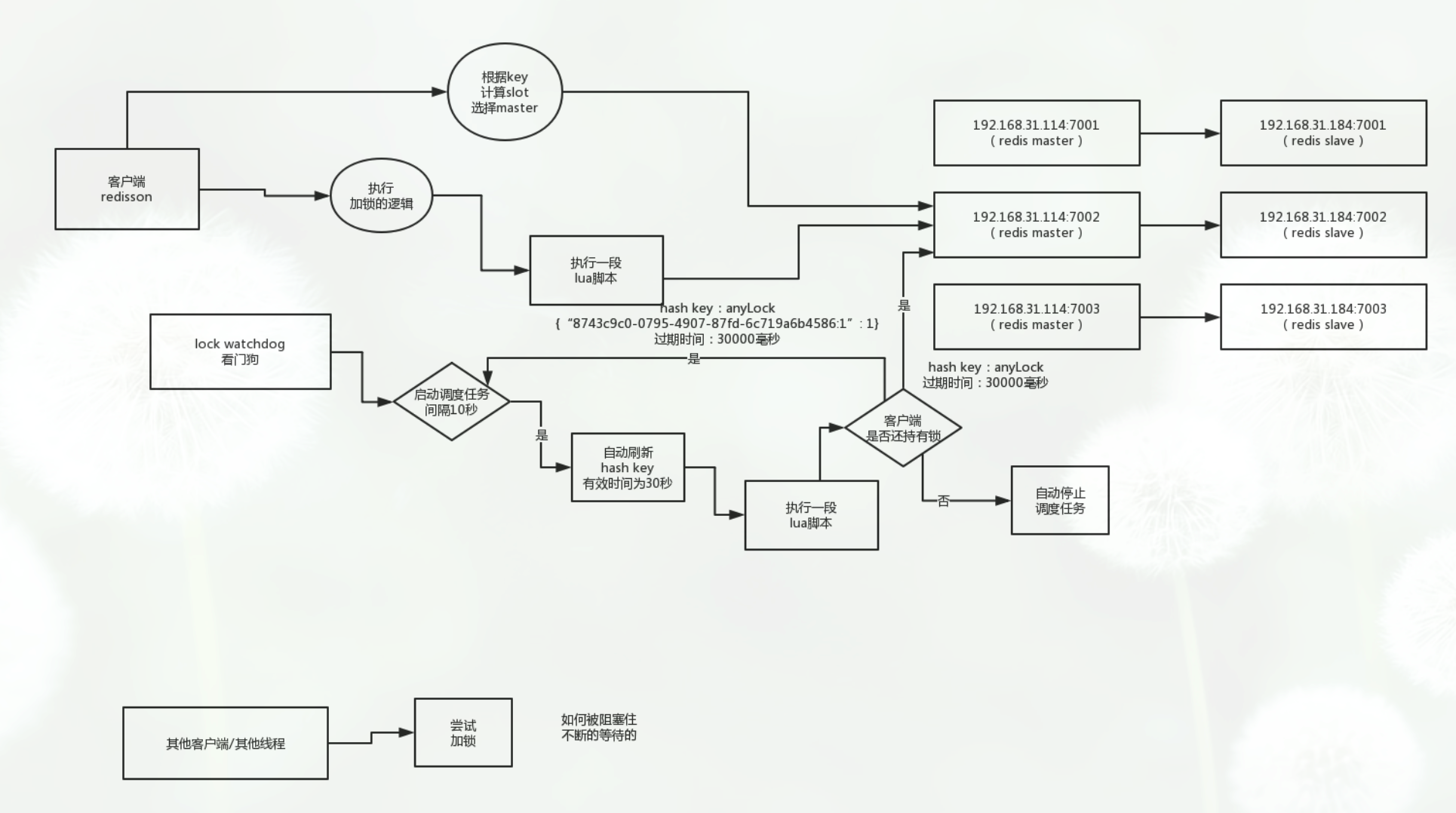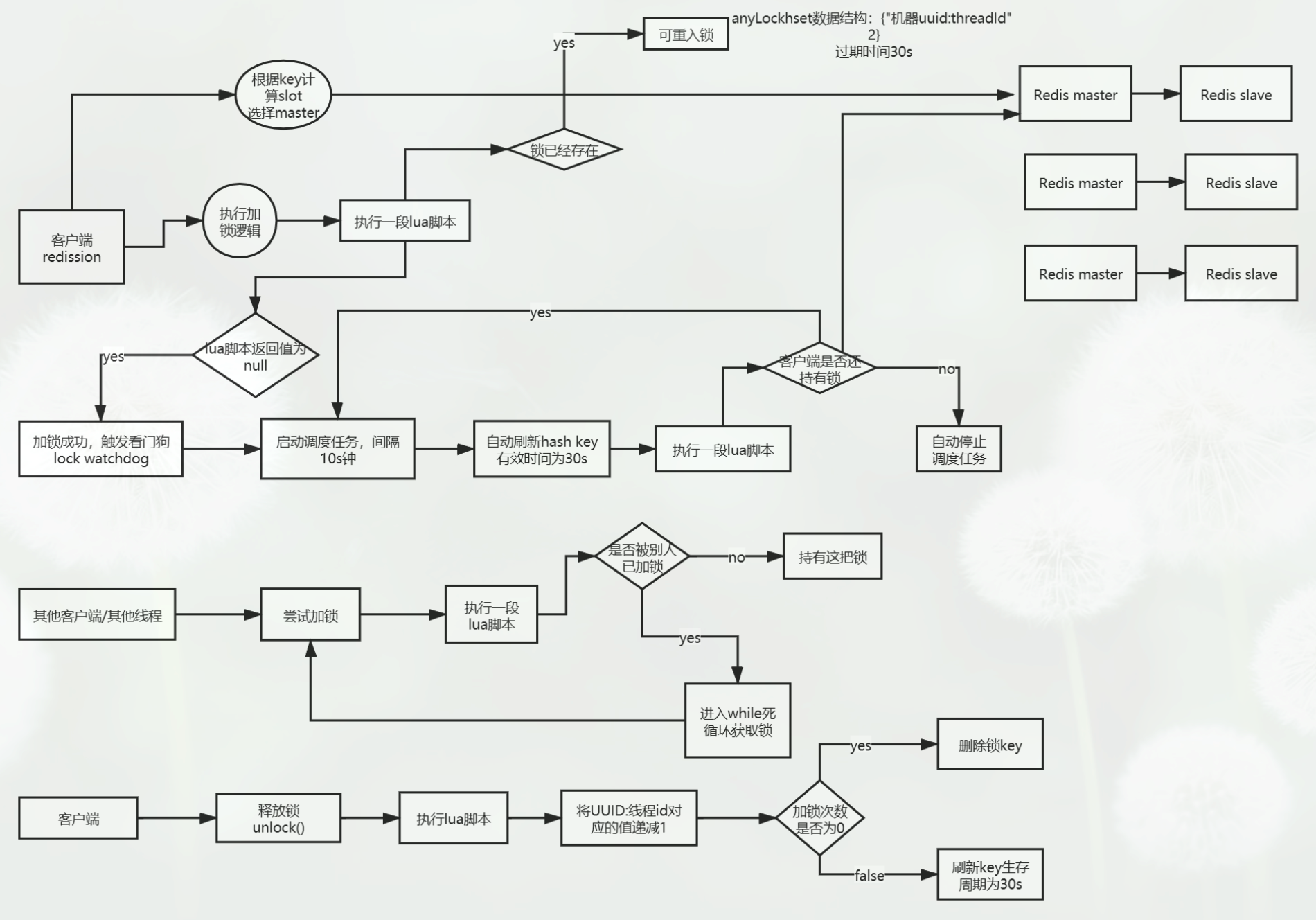Redisson
与 Jedis 的区别
- Jedis 提供了对 Redis-API 的简单封装,使用 Jedis 时,需要关注 Redis 服务器的部署细节,而 Redisson 屏蔽了这些细节,使得使用者可以将精力更集中地放到自己希望实现的功能上。
- Jedis 只提供简单的 API 调用,并不关注用户如何使用这些 API,比如 string 可以实现原子变量,不过需要用户手动封装,而 Redisson 中已经有了现成的 AtomicLong。
- Jedis 不支持 Cluster 环境下的事务、Lua
Sentinel 模式获取连接
1 | public class RedissonSentinelConnectionTest { |
- 确定 Sentinel 集群内的所有节点地址
创建连接管理器(ConnectionManager)时读取所有 Master、Slave 和 Sentinel 节点的地址(org.redisson.connection.SentinelConnectionManager#SentinelConnectionManager)
Sentinel 通过监听 master 可以得到所有节点的地址。
可以从SentinelConnectionManager中看到,客户端会定时(默认1秒)地刷新服务端状态,即使集群暂时不可用,也可以通过这种刷新来恢复连接。 - 尝试连接一个 Sentinel
只要有一个 Sentinel 能通过 PING-PONG 校验,则返回对该 Sentinel 的连接。 - 执行操作
获取连接(org.redisson.command.RedisExecutor#getConnection)。
如果是只读的操作,会从 slave 中通过负载均衡选一个操作(org.redisson.connection.MasterSlaveConnectionManager#connectionReadOp);
如果是非只读操作,从 master 里选一个操作(org.redisson.connection.ConnectionManager#connectionWriteOp)。
Cluster 模式获取连接
- 添加节点初始化 Redisson
对于客户端来说,Cluster 模式可以看做几个 Master、Slave 的组合(org.redisson.ClusterRunner#addNode)。 - 连接时从节点中选一个
以Buckets.get操作为例,跟踪代码直到CommandAsyncService#readAsync(String key, Codec codec, RedisCommand<T> command, Object ... params)先计算 key 属于哪个 slot(org.redisson.cluster.ClusterConnectionManager#calcSlot);1
2
3
4
5
6
7
8
9
10
11
12
13
14
15
16
17
18
19
20
21
22
23
24
25
26@Override
public int calcSlot(String key) {
...
// slot的计算方法,注意这里的MAX_SLOT是固定的
int result = CRC16.crc16(key.getBytes()) % MAX_SLOT;
log.debug("slot {} for {}", result, key);
return result;
}
private NodeSource getNodeSource(String key) {
// 计算该key属于哪个slot
int slot = connectionManager.calcSlot(key);
// 计算该slot属于哪个节点
MasterSlaveEntry entry = connectionManager.getEntry(slot);
return new NodeSource(entry);
}
@Override
public <T, R> RFuture<R> readAsync(String key, Codec codec, RedisCommand<T> command, Object... params) {
RPromise<R> mainPromise = connectionManager.newPromise();
// 获取key所在的节点
NodeSource source = getNodeSource(key);
async(true, source, codec, command, params, mainPromise, 0);
return mainPromise;
}
再由 slot 计算应该请求哪对主从(org.redisson.connection.MasterSlaveConnectionManager#getEntry)。 - 重连
Redisson启动后会创建一个定时任务每5秒更新一次节点状态,所以就算节点挂掉了,之后重启时客户端是可以感知到服务器的启动的。org.redisson.cluster.ClusterConnectionManager#scheduleClusterChangeCheck
分布式锁
文档:8. 分布式锁和同步器
下面记录一下 Redisson 中对应功能所在的代码位置和基本思路。
锁的特性
- 互斥性
任意时刻,只会有一个客户端持有锁 - 不会发生死锁
即使客户端在持有锁期间崩溃而没有释放锁,也能保证其他客户端能获取到锁。 - 容错性
锁服务的某个节点不可用时,客户端还能继续加解锁。 - 可重入性
一个客户端可以重复加锁,期间其他客户端无法获取这个锁。
可重入锁(Reentrant Lock)
测试代码见:org.redisson.RedissonLockTest#testGetHoldCount
源码主要为:org.redisson.RedissonLock
可重入性是通过加锁时传的 threadId 实现的,下面是 Redisson 中用于加锁的 lua 脚本(org.redisson.RedissonLock#tryLockInnerAsync):
1 | -- KEYS[1]: RedissonObject中的name字段,这里表示锁的名字 |
所有锁都保存在一个 key 为 lock 的 hash 对象下,第一次加锁时保存的结果为<lock, {threadId}, 1>,过期时间为 30s,同一线程第二次加锁时,更新为<lock, {threadId}, 2>,且过期时间被刷新。
当加锁成功时(包括同一线程调用重入多次)返回 null,而加锁失败时,返回锁的剩余过期时间,根据返回值是否为空可以判断加锁是否成功,当还未获取到锁时,客户端会轮询检查(org.redisson.RedissonLock#lock(long leaseTime, TimeUnit unit, boolean interruptibly)中的 while 循环),也就是说这种加锁方式并不是公平的。
加锁监控保证了当业务执行时间超过加锁时间时,不会因为锁过期而让其他线程进入临界区,在 Redisson 中是通过一个 TimerTask 每隔 10s(即加锁时间 / 3)刷新一次锁的过期时间来实现的(org.redisson.RedissonLock#renewExpiration)。
另外,由于加锁时保存了 threadId,unlock时同样会传 threadId、只能释放当前线程加上的锁,下面是用于释放锁的 lua 脚本(org.redisson.RedissonLock#unlockInnerAsync):
1 | -- KEYS[1]: {lockName} |
公平锁(Fair Lock)
测试代码见:org.redisson.RedissonFairLockTest#testIsLockedOtherThread
源码主要为:org.redisson.RedissonFairLock
公平性是通过队列实现的,(org.redisson.RedissonFairLock#tryLockInnerAsync):
1 | // remove stale threads |
联锁(MultiLock)
源码位置:org.redisson.RedissonMultiLock
联锁是对批量加锁的封装,其关键是如何实现死锁避免,其中的关键代码如下(org.redisson.RedissonMultiLock#tryLock(long waitTime, long leaseTime, TimeUnit unit)):
1 | // 将已经获取的锁释放掉 |
红锁(RedLock)
测试代码:org.redisson.RedissonRedLockTest#testLockLeasetime
源码位置:org.redisson.RedissonRedLock
红锁实际上是联锁的子类,原理基本一致,它和联锁的区别主要是:
- 联锁不允许加锁失败(
org.redisson.RedissonMultiLock#failedLocksLimit),而红锁允许少于半数次的加锁失败(org.redisson.RedissonRedLock#failedLocksLimit)。 - 使用时,红锁的加锁目标最好包含多个 Redis 实例,从而实现高可用。
如果一个Redis实例加多次锁,那么这个Redis挂掉了就会导致全部加锁请求都失败了。
红锁执行流程
- 获取当前时间戳;
- 开始获取锁:Client按顺序从每台Redis实例上获取锁;
注意每台服务器都有一个获取的截止时间,超过一段时间获取不到就放弃,而且这个截止时间要比总的获取锁的TTL时间要短很多,避免由于等待部分已停机的Redis实例时间过长而导致获取锁失败了。
比如总TTL为5s,那么每台Redis实例的获取时间就可以定为1s。
因为是顺序获取的,所以每台实例上锁的过期时间也是不一样的。 - 怎么样算获取成功:过半数,且未超时
- 过半数:比如总共有5个Redis实例的情况下,需要有至少3个实例成功获取到锁才算获取成功;
- 未超时:(总TTL) - (每台服务器获取锁花费的时间之和)需要大于0,如果获取成功,锁的真正有效时间就是这个时间差。
- 获取失败释放锁
不满足获取成功条件的情况下,把之前获取过锁的Redis实例都给释放掉。
锁续期 - 看门狗
看门狗原理,下图来自于这里
加锁时启动定时任务刷新锁的过期时间:
org.redisson.RedissonLock#tryAcquireOnceAsync
-> org.redisson.RedissonLock#scheduleExpirationRenewal
释放锁时关掉该定时任务:
org.redisson.RedissonLock#unlock
-> org.redisson.RedissonLock#cancelExpirationRenewal
可重入性
可重入性原理,下图来自于这里
红锁存在的问题
- 一般Redis集群都是多主多从,但是使用多主多从的情况下,锁是加到主服务器上的,而主从复制是异步完成的,如果在客户端获取到锁之后,主复制锁到从的过程中崩溃了,导致没有复制到从Redis中,那么之后即使再选举出一个从升级为主,主服务器里也是没有锁的,并且能够成功被获取到锁,导致互斥失效。
所以,使用红锁时Redis集群一般都是单节点,而不是主从的。 - 5主无从的情况下,如果一个客户端获取到锁之后,所有Redis重启,这时其他客户端又可以获取到锁了,显然违背了锁的互斥原则;如果Redis实例开启了AOF持久化存储,在持久化间隔时间内断电,照样会导致数据丢失。
显然AOF不能开启Always(每个命令都同步到硬盘),这样会造成性能急剧下降。
读写锁(ReadWriteLock)
TODO
信号量(Semaphore)
TODO
可过期性信号量(PermitExpirableSemaphore)
TODO
闭锁(CountDownLatch)
TODO
异常情况分析
- 因为主从同步导致锁被重复获取
Redis集群如果采用Cluster集群或Master-Slave主从复制的方式,就会存在key刚写完Master、但是在同步到Slave之前Master挂掉的情况,这时如果发生主从切换,就有可能会出现多个线程同时持有锁的情况。 - 因为GC导致锁被重复获取
如果出现GC停顿时间过长,或者其他情况导致客户端和Redis连接断开,也有可能出现多个线程同时持有一个锁的情况。